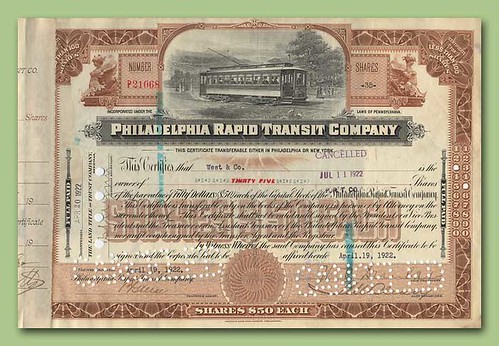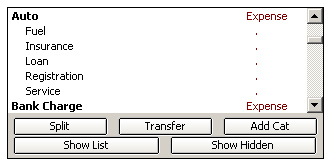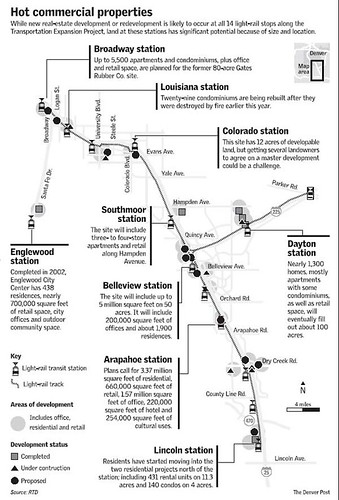A German bus driver threatened to throw a 20-year-old sales clerk off his bus in the southern town of Lindau because he said she was too sexy, a newspaper reported Monday. "Suddenly he stopped the bus," the woman named Debora C. told Bild newspaper. "He opened the door and shouted at me 'Your cleavage is distracting me every time I look into my mirror and I can't concentrate on the traffic. If you don't sit somewhere else, I'm going to have to throw you off the bus.'" The woman, pictured in Bild wearing her snug-fitting summer clothes with the plunging neckline, said she moved to another seat but was humiliated by the bus driver. A spokesman for the bus company defended the driver. "The bus driver is allowed to do that and he did the right thing," the spokesman said. "A bus driver cannot be distracted because it's a danger to the safety of all the passengers."
Monday, July 16, 2007
Too Sexy for This Bus
Sunday, July 15, 2007
Peter A.B. Widener, Transit Mogul
A transit mogul, Widener monopolized the street railways of Philadelphia. Starting in 1875, Widener and a partner began buying transit lines, modernizing the horse drawn cars first with cable cars, then with an electric trolley system that required the repaving of the city's streets. By 1895, the system supported 100 passengers a year.What is fascinating about this is how the money was made. Before Widener and a few others pioneered the collection of utilities to operate as one, each line and lighting company were separate in different sections of the city, leading to competition and the need to pay a different fare for each transfer.

But it was these moguls who paved the streets and lit the houses in New York, Chicago and Philadelphia, however through nefarious means. Dubbed syndicates, they were the reason we have the term 'Public Utilities' :
When Thomas A. Edison invented the incandescent light, and when Frank J. Sprague in 1887 constructed the first practicable urban trolley line, in Richmond, Virginia, they liberated forces that powerfully affected not only our social and economic life but our political institutions. These two inventions introduced anew phrase--"Public Utilities." Combined with the great growth and prosperity of the cities they furnished a fruitful opportunity to several particularly famous groups of financial adventurers. They led to the organization of "syndicates" which devoted all their energies, for a quarter of a century, to exploiting city lighting and transportation systems. These syndicates made a business of entering city after city, purchasing the scattered street railway lines and lighting companies, equipping them with electricity, combining them into unified systems, organizing large corporations, and floating huge issues of securities. A single group of six men--Yerkes, Widener, Elkins, Dolan, Whitney, and Ryan--combined the street railways, and in many cases the lighting companies...Charles T. Yerkes was the driving force behind Chicago's street railway and lighting was able to control city and state government officials. However in Philly, he was imprisoned for of all things embezzlement which led him to move to Chicago and opened up the door for a City Official named Peter A.B. Widener.
It was this circumstance in Yerkes's career which impelled him to leave Philadelphia and settle in Chicago where, starting as a small broker, he ultimately acquired sufficient resources and influence to embark in that street railway business at which he had already served an extensive apprenticeship. Under his domination, the Chicago aldermen attained a gravity that made them notorious all over the world. They openly sold Yerkes the use of the streets for cash and constantly blocked the efforts which an infuriated populace made for reform. Yerkes purchased the old street railway lines, lined his pockets by making contracts for their reconstruction, issued large flotations of watered stock, heaped securities upon securities and reorganization upon reorganization and diverted their assets to business in a hundred ingenious ways.Widener stepped up after Yerkes had gotten the previous city treasurer in trouble for the embezzlement. He was also a butcher, which apparently is a pretty big deal for politics.
A successful butcher shop in Philadelphia in those days played about the same part in local politics as did the saloon in New York City. Such a station became the headquarters of political gossip and the meeting ground of a political clique; and so Widener, the son of a poor German bricklayer, rapidly became a political leader in the Twentieth Ward, and soon found his power extending even to Harrisburg.
He also picked up a bond partner in Elkins and the two came into control of Philadelphia's traction organization.

Widener and Elkins, however, not only dominated Philadelphia traction but participated in all of Yerkes's enterprises in Chicago and held an equal interest with Whitney and Ryan in New York. The latter Metropolitan pair, though they confined their interest chiefly to their own city, at times transferred their attention to Chicago. Thus, for nearly thirty years, these five men found their oyster in the transit systems of America's three greatest cities--and, for that matter, in many others also.Later on, the syndicate ended up buying the Broadway Traction Company in New York City. This led to their organization being the first holding company.
This Broadway franchise formed the vertebral column of the New York transit system; with it as a basis, the operators formed the Metropolitan Street Railway Company in 1893, commonly known as the "Metropolitan." They organized also the Metropolitan Traction Company, an organization which enjoys an historic position as the first "holding company" ever created in this country.
It's a fascinating story and the Age of Big Business is definitely a good read and as much as I want to, I can't quite cover it all without just copying and pasting the whole thing.
Tampa Not So Fast in Space Race
By that time, the initial space race will be over. Denver, Salt Lake City, and Dallas will each have over 100 miles of rail lines and Tampa will have a small starter line. As my old track coach Bubba used to say, Pick It Up!- A primary rail line with four main stations: downtown St. Petersburg, the Gateway-Toytown area, West Shore district and downtown Tampa. It would cross the bay on a new structure between the Howard Frankland's two spans. The current bridge was designed with that in mind, although it would be expensive.
- Radiating out from that primary "spine," you'd have "ribs" - railways and express buses to the beaches, Clearwater and the University of South Florida, eventually reaching as far as Brooksville, Lakeland and Sarasota.
- Ferries traveling between downtown St. Petersburg, Tampa, Bradenton and possibly Apollo Beach.
Train, boat and bus fares would cover only a fraction of the costs. Local transit officials think the most realistic way to start paying for these things is to follow the lead of numerous other cities, including Miami and Jacksonville: Ask voters for a half-cent sales tax.
Friday, July 13, 2007
Transit Trading Cards

Then I got to thinking, what are the statistics for that bus? What kind of grades can it operate on? How much power is produced by the motor? Then I immediately shot back to when I was a little kid trading Ken Griffey Jr. and Craig Biggio baseball cards. I knew everyone's stats and had them memorized. I also had micro machines and my friends and I liked collecting them. My favorite was the Star Wars A-Wing fighter. I can still tell you that it can go 120 MGLT, faster than any fighter ship in the Star Wars galaxy (At the time of my last guidebook, it might have changed).

But why can't we have transit vehicles portrayed in the same way with stats and figures? Why can't we take a wikipedia entry and make micromachines out of the Siemens Combino or the S70 vehicles (which do not have a wikipedia entry)? There could be old time streetcars as well with Birney Safety Cars in a set with PCCs. Add in some historic buses. The point is that you can give younger folks, and even folks my age a reason to get excited when they see transit. Kids would know all of the streetcar types and would get excited when they saw them in cities. It would also make the city seem more interesting to kids who might never have been exposed to it living in the burbs.
The only reason I know about rapid transit is because my dad and I used to ride BART to the auto show at the Moscone Center during Christmas holiday on our visits to my grandparents house. Pop culture feeds kids cars in the form of hotwheels, power wheels and micro machines, if we want to change views of transit, we have to look at how they get into our sub conscience so early. Perhaps trading cards, perhaps hasbro?
Thursday, July 12, 2007
Feeling the Pain of Parking
For developers in New York, parking is the highest and best use for below-grade space and fetches about the same price per square foot as actual living space, which costs much more to develop. According to Miller Samuel, the average parking space costs $165,019, or $1,100 per square foot, close to the average apartment price of $1,107 per square foot. Those are averages, of course. A $200,000 parking space is about $1,333 per square foot.
Siemens Combino in Budapest
But I'll make sure I pay the fare, instead of perhaps doing it the more dangerous way as seen below.
Tuesday, July 10, 2007
Rail on Daily Kos
Part 1. Local Rail
Part 2. Rapid Transit
It's an interesting series and spawned a lot of discussion when some bus oriented folks tried to spread talking points from some libertarian think tanks including the Cascade Policy Institute. My favorites included the use of Portland's stat sheet to point out that buses were better than rail in operating hours and also someone arguing on behalf of the Bus Riders Union talking points. One person went so far as to say that each LRV costs $12 million which is ridiculous.
In any event i'm going to re-post some excerpts of my comments below...
...More stats from that ridership chart (Portland, 2004) that matter... Lets look at subsidy per rider, .62 cents for rail to $1.20 for bus, the cost per passenger mile (because we are comparing two different service types) .68 cents for bus versus .29 cents per passenger mile for rail and Max carries 41% of the passenger miles!...
...his argument really revolved around the thought that you could replace a whole system with buses, but then you look at how much they cost per passenger mile and staffing those some 6,000 buses would have broken the operating bank...
...So lets look at the cost of buses versus trains in real costs...just vehicles. In 2007 your transit authority buys two LRVs for six million. It carries 464 passengers per two car consist with one driver. 60 foot articulated buses (nothing longer is legal in the US nor should it be if it is on the same streets as cars) carry 90 passengers max. So to carry the load of the LRT you need about 5 buses. Those 5 buses cost about a million each, each need a driver and have to be replaced in 12 years which means in 24 years you have spent 6 million on two LRVs and 10 million on 10 buses not to mention inflation for the 12 year bus replacement. Then, you have the costs of paving the roads, which in the case of the Orange Line in LA are already messed up (photo proof) But no one ever adds those costs in. Nor do they mention that rail attracts 34-43% more riders...
...Let's also look at energy usage...The Department of Energy Oakridge Lab puts out data every year. The most recent shows rail on top again. 4,318 BTU per passenger mile for bus versus an average of 2,978 BTU per passenger mile of any rail (Amtrak, Rapid Transit and Commuter Rail)...
And so on and so forth. Go ahead and check out Kos. If you aren't a diarist over there you might want to sign up so you can take part in the discussions. However it takes a week I believe before you can post because they don't want folks to just make up names and jump on.
Monday, July 9, 2007
Katy Freeway and Wasted Opportunities
It's might be better in the long run. Because we really don't want to have rail in the median of a freeway. It might be cheaper but I'm not sure its so great for urbanism given that the high speeds and winds generated from the freeway. It scares away pedestrians. Denver's line seems to be doing well. But I think if there was a subway through Orinda and Lafayette on BART, they would be much different places.
Sunday, July 8, 2007
Autocentricity in Consumerism

But what does this say about the overall consumer culture and our debt? Given that the median balance on the American credit card is $1,900, and 43% of Americans spend more than they earn, does this mean we are slaves to our cars?
According to this MSN Money article, the debt of America outside of our Mortgage is largely tied to non-revolving loans like the ones available for people to buy cars. That's just the capital cost for the car. Now what about operating the thing and roads? In 2005, the average American spends 18% of their income on transportation. Recent research suggests that this fluctuates between the exurbs and transit rich urban core with a difference of up to 16% between the extremes of 25% and 9% respectively.
In my own experience, I drive my car once a week and fill up the tank once a month. I probably wouldn't drive at all if my grandmother didn't live so far from BART. Otherwise I take Muni, BART, or walk. I would say that I'm around the 9% in transportation costs which allows me to pay a bit more in rent than I normally would be able to afford. But I'm also able to save up some money.
So in a consumer based, auto oriented society, we are largely tied to our cars, figuratively and sometimes literally. Over the last 60 years we've been so tied down that even personal finance software doesn't give us a transit choice but to enter it in ourselves. But as we've found out from parking, when given the choice for someone to unbundle, a lot of people will choose the alternative because there is one to choose. Someone gave an analogy recently, and forgive me for stealing it if you're reading but if there is a shelf full of only Pepsi how can you say that no one wanted to buy Coke? The choice wasn't there.
Friday, July 6, 2007
Denver Ridership

In their 2006 TOD Status Report, RTD-Denver, the local transit authority, reports that...
Some 3,704 residential units, 460,000 square feet of retail, and 300,000 square feet of office space have either been built or are currently under construction...An additional 3,713 residential units, 600 hotel rooms, 440,000 square feet of retail, 860,000 square feet of office space have been proposed. When added to projects at the I-25/Broadway transfer station, these 15 proposed projects have been an estimated value of approximately $1.7 billion.That's a good amount of TOD and I'm sure that some of the completed units have contributed to the elevated ridership.
